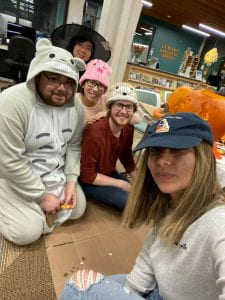Ken is a current student in the LTS MA Program with a strong interest in revising curricula to be more inclusive for heritage learners.
Hello Ken! How are you holding up in these strange times? How are you balancing your studies and hobbies?
I am doing well in these times, just some difficulties with having a consistent sleeping schedule. To balance the studies and hobbies, I try to make sure to do something fun or relaxing each day. For example, after doing an online synchronous meeting for a class, I would take a break watching a YouTube video or play a bit of my videogames. Checking the deadline for upcoming assignments is a good way to plan break times between the assignments that are going to be due soon.
You are following the 2-year version of the program. What have been the advantages of doing this in your case?
With the two-year program I have been able to explore classes from different departments. I took a couple of Spanish classes in the Romance languages department, which it was helpful to get a better idea of what I would like to do for my final project. It was also a good experience that I was able to do GE positions as a first-year Spanish teacher and a TA for a Japanese art history class. Even though I decided on the 2-year program from early on, I still took most of the required classes in the first year. I think this was helpful for preparing for the second year. This is because now I can focus on my final project and take elective classes. I am taking first-year Portuguese and it has been an illuminating experience going back to being a learner of a foreign language after taking classes and teaching first-year Spanish the previous year.
Could you tell us more about your specific interests, and what your MA project will likely be about?
I am interested in teaching Spanish in the University context and specifically to Spanish heritage students. In addition, I like Computer assisted language learning (CALL), flip learning, and content-based instruction. My master’s project is going to be a curriculum design for a first-year Spanish class for Spanish heritage students, who are receptive bilinguals. Meaning that their experiences with the Spanish language has been limited to mostly listening other members of their community speaking Spanish. This class will focus on developing their literacy and speaking skills. It will also implement critical pedagogy, so that the students learn about the power that dominates over language use and develop their critical thinking. The class design will be designed for in person with online elements. I will use CALL elements in the class as well, so that the students have another place to interact with each other and produce language. Some of these activities using CALL will be online photo diaries entries that the students share with each other on a blog forum. There will also be online blog that will use video to post a response to each other. While it will not be a synchronous interaction, the students can practice and choose the best version of the language that they produce in the videos.
What inspired you to do this kind of project?
My background in language learning is that I am a heritage learner of Spanish and Japanese. While growing up the schools that I assisted did not have support for heritage students, so it was a difficult experience trying ton balance learning different languages. Since I have experiences as a receptive trilingual, I want to help other students who are facing the stress and challenges of understanding a language but not being able to produce the language. Before the pandemic I became involved with the Spanish heritage club at the University of Oregon. I attended their events and hosted a movie screening with other graduate students for the undergraduate SHL students.
Do you have any suggestions for students who are just starting the program in a remote environment?
By taking classes in a remote environment, it can be easy to mix your downtime/breaks with being productive in your classes. So, I recommend scheduling a time where you will not be in front of a computer and will be doing something else that is not school related. If you have to do readings for a class that are pdf files, you could print them out and do the reading in paper. This way there is less time spent looking at a screen. You can get a good perspective of what you think the online classes elements you like or don’t like as much. Because it can give you some insight of what you should do if you were to do an online class. I think it is important to learn how to online classes, now that the pandemic has accelerated the demand and need of more online education. Another thing is that even if you can’t meet fellow people from the cohort in person, you should try to meet them online. You could meet them for a study session, or hangout/talking to get to know each other better.


